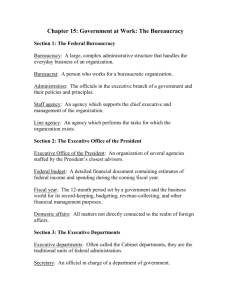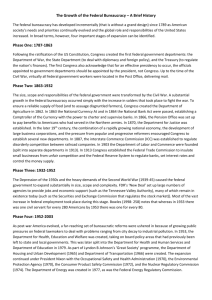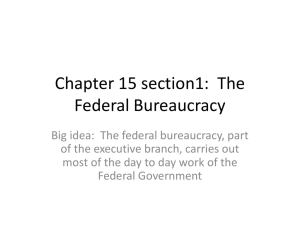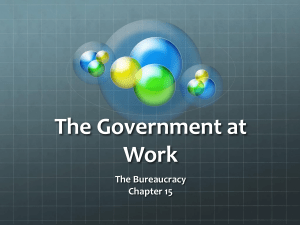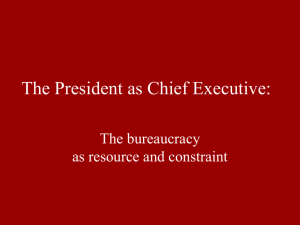Chapter 15 Worksheets (Students Notes)
advertisement
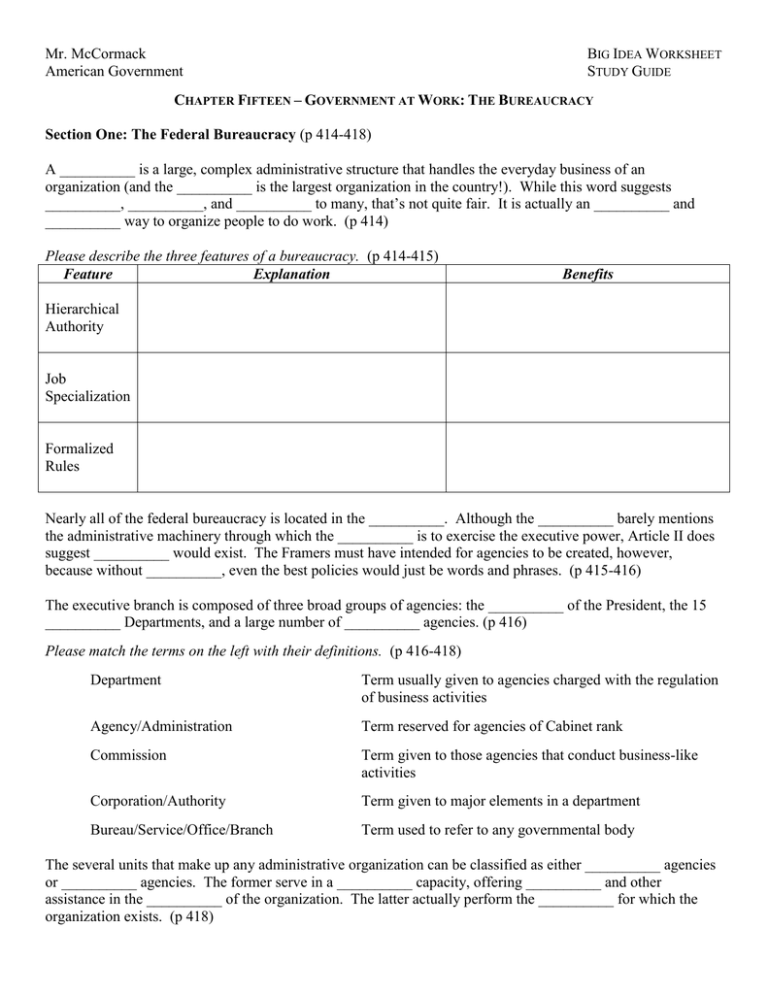
Mr. McCormack American Government BIG IDEA WORKSHEET STUDY GUIDE CHAPTER FIFTEEN – GOVERNMENT AT WORK: THE BUREAUCRACY Section One: The Federal Bureaucracy (p 414-418) A __________ is a large, complex administrative structure that handles the everyday business of an organization (and the __________ is the largest organization in the country!). While this word suggests __________, __________, and __________ to many, that’s not quite fair. It is actually an __________ and __________ way to organize people to do work. (p 414) Please describe the three features of a bureaucracy. (p 414-415) Feature Explanation Benefits Hierarchical Authority Job Specialization Formalized Rules Nearly all of the federal bureaucracy is located in the __________. Although the __________ barely mentions the administrative machinery through which the __________ is to exercise the executive power, Article II does suggest __________ would exist. The Framers must have intended for agencies to be created, however, because without __________, even the best policies would just be words and phrases. (p 415-416) The executive branch is composed of three broad groups of agencies: the __________ of the President, the 15 __________ Departments, and a large number of __________ agencies. (p 416) Please match the terms on the left with their definitions. (p 416-418) Department Term usually given to agencies charged with the regulation of business activities Agency/Administration Term reserved for agencies of Cabinet rank Commission Term given to those agencies that conduct business-like activities Corporation/Authority Term given to major elements in a department Bureau/Service/Office/Branch Term used to refer to any governmental body The several units that make up any administrative organization can be classified as either __________ agencies or __________ agencies. The former serve in a __________ capacity, offering __________ and other assistance in the __________ of the organization. The latter actually perform the __________ for which the organization exists. (p 418) Mr. McCormack BIG IDEA WORKSHEET American Government STUDY GUIDE CHAPTER FIFTEEN – GOVERNMENT AT WORK: THE BUREAUCRACY Section Two: The Executive Office of the President (p 419-422) The Executive Office of the __________ (“EOP”) is an __________ agency, a complex organization staffed by the President’s closest __________ and __________. It was first established in __________ but has been reorganized repeatedly since then. (p 419) The “__________” of the entire executive branch is the __________. It houses the President’s key personal and political __________. The __________ directs all of the operations of the White House Office and is among the most influential of aides. The staff also includes such other major aides as the __________, the __________, and the __________. The __________ visible place in public life today is reflected by the staff as well. (p 419-420) Most of the President’s major steps in __________ are taken in close consultation with the __________. Its members include the __________, the secretaries of __________ and __________, the director of the __________, and the __________ of the Joint Chiefs of Staff. (p 420) The Office of __________ and Budget (“OMB”) is the __________ and, after the White House Office, the most __________ unit in the Executive Office. Its major task is the preparation of the __________. (p 421) The federal __________ is a very detailed estimate of __________ and __________ for the next __________ year, a __________-month period that begins on __________. It is more than a __________ document, though. It is an annual statement of the __________ expressed in dollars. The creation of this document is a lengthy process that begins when each __________ submits estimates of its needs to the OMB. The OMB reviews those proposals and incorporates them into the president’s program. (p 421) The OMB also __________ the spending of funds that Congress appropriates. Beyond its budget chores, the OMB checks and clears agency stands on all __________ matters to make certain they agree with the president’s policy positions. It also helps the president prepare the hundreds of __________ he issues each year and the __________ messages he occasionally sends to Congress. (p 421) Please describe what each of the following agencies does. (p 421-422) Agency Function Office of Faith-Based and Community Initiatives Office of National Drug Control Policy Council of Economic Advisors Office of Policy Development Council on Environmental Quality Office of the Vice President Office of the United States Trade Representative Office of Science and Technology Policy Office of Administration Mr. McCormack American Government Central Dauphin High School BIG IDEA WORKSHEET STUDY GUIDE CHAPTER FIFTEEN – GOVERNMENT AT WORK: THE BUREAUCRACY Section Three: The Executive Departments (p 424-429) Much of the work of the federal government is done by the __________ executive departments, often called the __________ departments. They are the traditional units of federal administration, and each is built around some broad field of __________. (p 424) The first Congress created __________ departments in 1789: __________, __________, and __________. Other departments were created later, while some were later __________ or abolished. (p 424) Each department is headed by a __________, except for the Department of __________, which is led by the __________. (p 424) Each department is made up of a number of __________, both staff and line, which are further divided into smaller __________. Many of the agencies are structured __________, with much of their work done through __________ or __________ offices. Please familiarize yourself with the 15 departments and answer the following questions. (p 425-427) Which department is the oldest and most prestigious? __________ Which department is the largest? __________ Which department has the largest budget? __________ Which department conducts nuclear weapons research and production? __________ Which department operates hydroelectric power plants? __________ Which department administers the food stamp program? __________ Which department enforces alcohol, tobacco, and firearms laws? __________ The __________ is an informal advisory body, neither mentioned in the __________ nor created by __________. It includes the head of each of the 15 departments, but presidents regular add other members, including the director of the __________ and the president’s chief __________ advisor. The __________ is a regular participant, as are others. (p 426-427) What are some factors presidents consider when picking their cabinet secretary nominees? (p 427-428) _______ __________________________________________________________________________________________ Cabinet members have __________ major jobs. Each is the __________ head of a department; collectively, they are __________ to the president. Some presidents give their cabinets great attention, others don’t; some have leaned on alternative advisory groups. No president has ever suggested __________ it, however. (p 429) Mr. McCormack BIG IDEA WORKSHEET American Government STUDY GUIDE CHAPTER FIFTEEN – GOVERNMENT AT WORK: THE BUREAUCRACY Section Four: Independent Agencies (p 430-435) Until the 1880s, most of the government’s work was done through its __________, but since then a large number of __________ agencies have been created. Some have been set up outside the regular __________ simply because they don’t fit well anywhere else. Some are independent to protect them from both __________ and __________ pressure, while others are independent because that’s what certain __________ wanted. Many are independent largely by __________. Finally, some are independent due to the __________ nature of their functions. In spite of their label, most of these groups are not truly free from __________ control. (p 430-431) Most of the independent agencies are independent __________ agencies. They are organized much like __________ but they do not have __________ status. Most operate far from the __________ and rarely attract attention. Three examples: _____________________________________________________________ (p 431) Independent __________ Commissions are those agencies that are largely beyond the reach of __________ direction and control. Each has been created to regulate, or __________, important aspects of the nation’s __________. Members of a commission have __________ of such length that it’s unlikely that a __________ will gain control over them, and no more than a bare majority of them may belong to the same __________. Most of these officers can only be removed for causes that __________ has specified. (p 431-432) While these commissions are __________ bodies, they are also quasi-__________ and quasi-__________. They make __________ and __________ that have the force of __________. They also decide disputes in those fields where Congress has given them __________. These commissions are exceptions to the principle of __________. (p 432-433) Critics have raised serious questions about these agencies and proposed to __________ or __________ them. Congress has responded to their questions by __________ much of the nation’s __________ industry. Two major regulatory bodies have actually __________ in recent years. (p 433-434) Government __________ were set up by Congress to carry out certain __________-like activities. There are now more than __________ of them. Three examples: _______________________________________(p 434) The typical government __________ is run much like one in the __________. There are differences, however. Three differences include: (p 435) 1. __________________________________________________________________________________ 2. __________________________________________________________________________________ 3. __________________________________________________________________________________ Section Five: The Civil Service (p 437-440) The civil service is composed of those __________ employees who perform the administrative work of government. The president appoints the people who hold the __________ jobs in the executive branch, while all of the other jobs are covered by some aspect of the __________. (p 437) __________ has been called the father of the __________, the practice of giving __________ and other __________ of government to political supporters and friends. In fact, __________ laid the foundations of the idea at the federal level in 1801. This practice, also known as __________, what widely used at the state and local levels long before. (p 438) How did Andrew Jackson defend the spoils system? (p 438) 1. __________________________________________________________________________________ 2. __________________________________________________________________________________ 3. __________________________________________________________________________________ 4. __________________________________________________________________________________ In spite of those arguments, more saw the system as a way to build and hold __________. Many posts were filled by __________. Inefficiency and even __________ became the order of the day. Much of the nation’s wealth was __________. (p 438) Able people pressed for __________, but little came of their efforts. Congress did create a __________ in 1871, but it soon died away. In 1881, though, President __________ was assassinated by a disappointed officeseeker, __________. President __________ passed the __________ Act, the Civil Service Act of 1883. (p 438) This act laid the foundation for the modern system. Its main purpose was to make __________ the basis for hiring, promotion, and other personnel actions. This was to be measured by __________ given by an independent agency. Although this act initially covered only __________ of the government’s employees, today nearly __________ are covered by the system. (p 439) Today most federal employees are hired through a __________. They are paid and promoted on the basis of __________ by their __________. They are generally protected from __________ actions or __________ for __________ reasons. (p 439) The Office of __________ is now the government’s central personnel agency. It advertises for __________, __________ those who apply, and keeps __________ (lists of applicants qualified for employment). (p 439) Another independent agency, the __________ Systems __________ Board, enforces the merit principle. The Board includes members from __________. It hears appeals from federal workers who have complaints about __________. (p 440) Although __________ are well represented in most agencies, they tend to be concentrated in __________ positions. __________ sets the pay and other job conditions for everyone who works for the federal government, except those in the US __________. At lower levels, civil service pay compares fairly well with salaries in the __________, but government can’t compete at the higher levels. (p 440) Several laws and regulations restrict the __________ of civil servants. The first of two major laws, the __________ Act of 1939, allowed federal workers to __________ in elections but prohibited them from taking part in __________ activities. The Supreme Court has rejected several __________ Amendment challenges to this law. (p 440) The second major law, passed in __________, relaxed many of the older restrictions. Today, a federal worker has the right to __________, help register new __________, contribute __________ to candidates and parties, participate in __________, and even hold __________ in a political party. The worker may not __________ in elections, engage in party work on __________ or while on the __________, collect political contributions from __________, or use a __________ to influence an election. (p 440)
